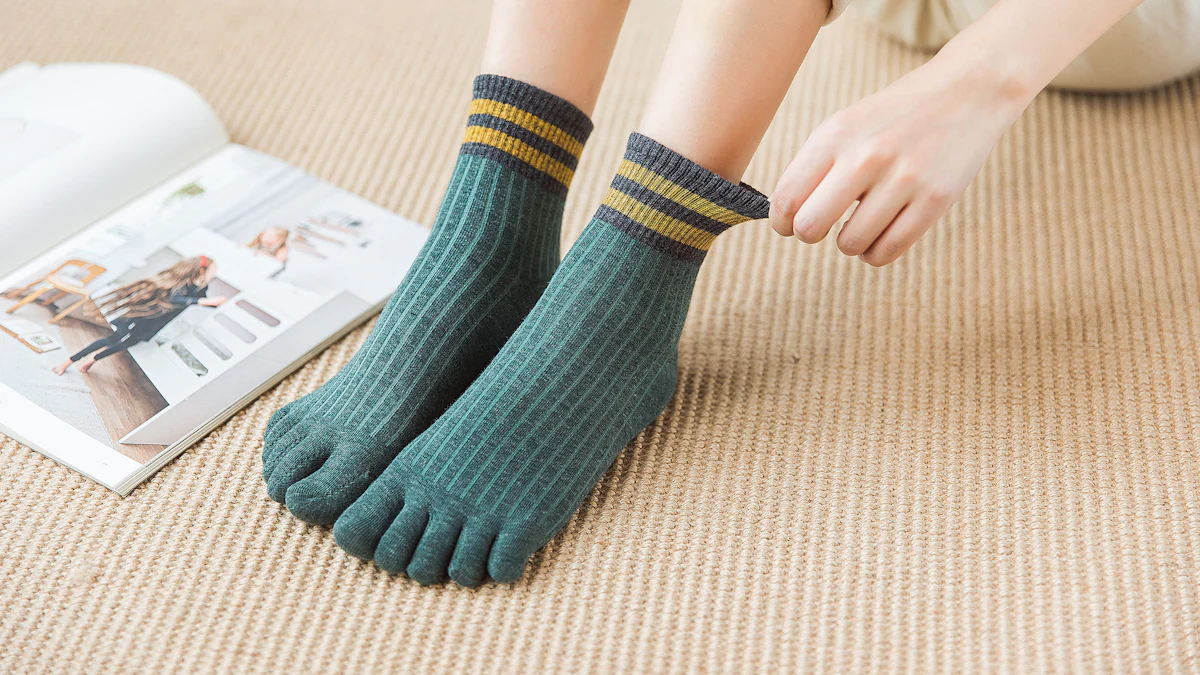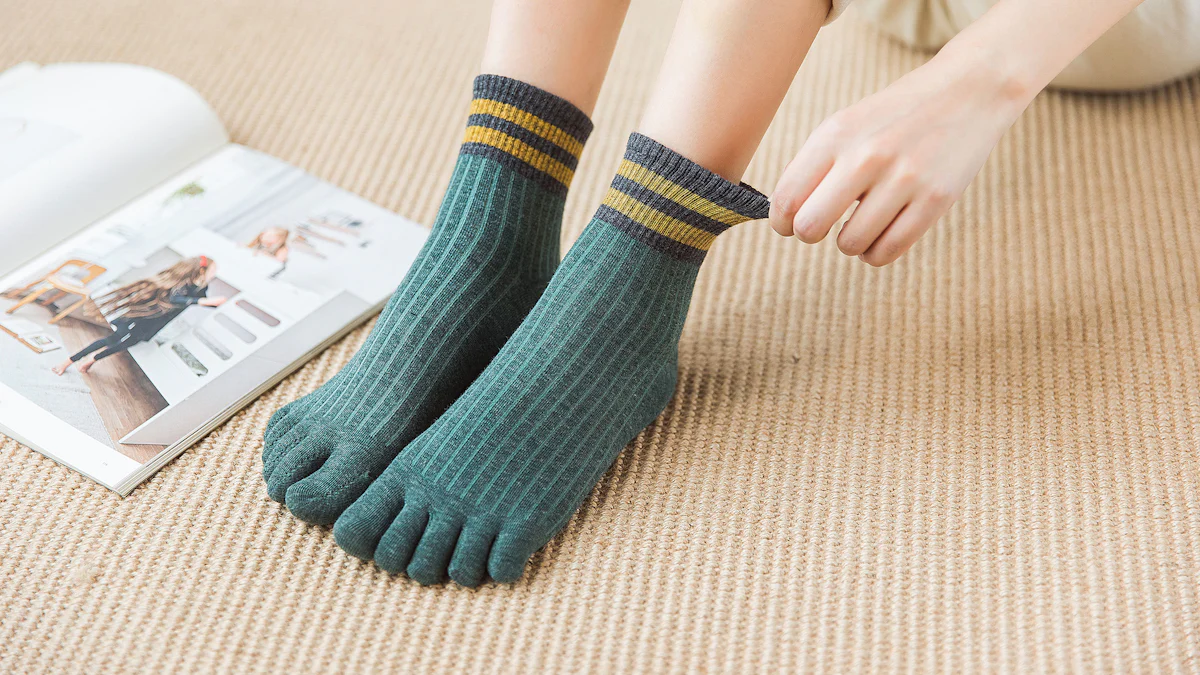
Socks come in various materials, each offering unique benefits. Traditional sock materials include cotton, wool, and synthetic fibers like nylon. Recently, there has been a growing interest in nylon-free socks. These socks avoid the use of man-made filaments, focusing instead on natural fibers. The purpose of this blog is to explore why nylon-free socks are the best choice for health, comfort, and sustainability.
Historical Context of Sock Materials
Evolution of Sock Materials
Early Materials Used in Socks
Early socks used materials like wool and cotton. Wool provided warmth and durability. Cotton offered comfort and breathability. In the Middle Ages, socks became vital accessories. People from all social classes wore them. Nobility sported high, legging-like socks as status symbols. By the 17th century, cotton socks allowed for various styles and shades.
Introduction of Synthetic Fibers
The industrial revolution in the 18th century transformed sock production. Mass manufacturing techniques emerged. This made socks widely available and affordable. The invention of the knitting machine further revolutionized sock production. Synthetic fibers like nylon and polyester appeared in the 20th century. These new materials changed sock construction.
Rise of Nylon in Sock Production
Benefits of Nylon in Socks
Nylon was invented in 1938. This synthetic fiber brought several benefits to sock production. Nylon offered incredible resistance and strength. It enabled stretchability and improved durability. Nylon also helped socks retain their shape. This material created a snug fit and provided arch support. Nylon’s moisture-wicking properties kept feet fresh.
Popularity and Widespread Use
Nylon quickly gained popularity in sock production. Its affordability and versatility made it a preferred choice. By the late 1950s, nylon and spandex dominated the market. These materials revolutionized sock manufacturing. Nylon’s lightweight and quick-drying properties made it ideal for hiking socks. The widespread use of nylon changed the landscape of sock materials.
Benefits of Nylon-Free Socks

Health and Comfort
Breathability and Moisture Management
Nylon-free socks excel in breathability. Natural fibers like cotton and wool allow air to circulate around the feet. This circulation helps keep feet cool and dry. Unlike nylon, natural fibers do not trap heat and moisture. Soggy socks can encourage bacterial and fungal growth. This can lead to health concerns. Nylon-free socks manage moisture better, reducing these risks.
Reduced Risk of Allergies and Skin Irritation
Natural fibers in nylon-free socks reduce the risk of allergies. Synthetic materials like nylon can irritate sensitive skin. Cotton and wool are less likely to cause skin reactions. People with allergies often prefer nylon-free socks. These socks provide a safer option for those with sensitive skin.
Environmental Impact
Biodegradability and Sustainability
Nylon-free socks offer significant environmental benefits. Cotton socks are biodegradable. This means they break down naturally without harming the environment. Wool also decomposes over time. Synthetic materials like nylon do not biodegrade easily. They contribute to long-term waste. Choosing nylon-free socks supports sustainability.
Reduced Carbon Footprint
The production of nylon-free socks has a lower carbon footprint. Manufacturing synthetic fibers requires more energy. This process releases more greenhouse gases. Natural fibers like cotton and wool have a smaller environmental impact. Using these materials reduces overall carbon emissions. Consumers can make an eco-friendly choice by selecting nylon-free socks.
Durability and Performance
Natural Fiber Strength
Nylon-free socks can be very durable. Wool and cotton provide natural strength. These materials withstand wear and tear well. While nylon adds durability to socks, natural fibers can also perform strongly. Experiments have shown that nylon-free socks can last long. Reinforcement techniques enhance their durability.
Long-lasting Wear
Nylon-free socks offer long-lasting wear. Proper knitting techniques improve their lifespan. Natural fibers maintain their integrity over time. Users find that nylon-free socks remain comfortable and functional. The initial investment in high-quality, nylon-free socks pays off. These socks provide value through extended use.
Practical Considerations

Cost Comparison
Initial Investment vs. Long-term Savings
Nylon-free socks often require a higher initial investment compared to nylon socks. The use of natural fibers like cotton and wool increases the cost of production. However, this investment can lead to long-term savings. High-quality, nylon-free socks tend to last longer due to durable knitting techniques and reinforcement tricks. Over time, the need to replace socks less frequently can offset the initial cost. Consumers may find that spending more upfront results in better value over the lifespan of the socks.
Availability and Variety
Market Trends and Consumer Demand
The market for nylon-free socks has grown significantly. Increasing awareness of environmental issues drives consumer demand for sustainable products. Many brands now offer a wide range of nylon-free options. Shoppers can find socks made from organic cotton, bamboo, and other eco-friendly materials. The variety available caters to different preferences and needs, making it easier for consumers to make environmentally conscious choices.
Options for Different Needs and Preferences
Nylon-free socks come in various styles and designs. Manufacturers produce socks for different activities, including casual wear, sports, and formal occasions. Natural fibers provide comfort and performance suitable for diverse uses. For instance, cotton socks offer breathability ideal for everyday wear, while wool socks provide warmth for colder climates. The range of options ensures that consumers can find nylon-free socks that meet their specific requirements, whether for fashion, function, or both.
The blog has highlighted the numerous advantages of choosing nylon-free socks. Key points include the health benefits, such as improved breathability and reduced risk of skin irritation. Environmental benefits include biodegradability and a lower carbon footprint. Practical considerations show that nylon-free socks offer long-lasting wear and can be cost-effective over time.
Switching to nylon-free socks can enhance comfort, support sustainability, and provide better value. Consider making the switch for a healthier, more eco-friendly lifestyle.

